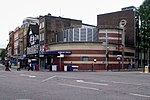St George the Martyr, Southwark

St George the Martyr is a church in the historic Borough district of south London. It lies within the modern-day London Borough of Southwark, on Borough High Street at the junction with Long Lane, Marshalsea Road, and Tabard Street. St George the Martyr is named after Saint George. The church is a Grade II* listed building.The church has strong associations with Charles Dickens, whose father was imprisoned for debt in the Marshalsea prison. The surviving wall of the prison adjoins the north side of the churchyard. Dickens himself lived nearby, in Lant Street, lodging in a house that belonged to the Vestry Clerk of St George's. This was during the darkest period of his life when, as a teenager, with his father in prison, he had to work in the 'blacking factory', and his literary career must have seemed an impossible dream. Later, he was to set several scenes of the novel Little Dorrit in and around St George's Church. There is a small representation of Little Dorrit in the east window of the church.It is also a recognised church of the City of London Company of Parish Clerks and the guild church of the Guildable Manor. From 2008 the annual Southwark Quit Rents ceremony, before the Queen's Remembrancer has taken place there.
Excerpt from the Wikipedia article St George the Martyr, Southwark (License: CC BY-SA 3.0, Authors, Images).St George the Martyr, Southwark
Great Dover Street, London Borough (London Borough of Southwark)
Geographical coordinates (GPS) Address Website External links Nearby Places Show on map
Geographical coordinates (GPS)
| Latitude | Longitude |
|---|---|
| N 51.501263 ° | E -0.092671 ° |
Address
St George the Martyr (St George the Martyr with St Alphege and St Jude, Southwark)
Great Dover Street
SE1 1AA London, Borough (London Borough of Southwark)
England, United Kingdom
Open on Google Maps








